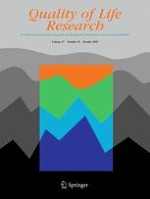16-06-2018
Fatigue in the general population: German normative values of the EORTC QLQ-FA12
Gepubliceerd in: Quality of Life Research | Uitgave 10/2018
Log in om toegang te krijgenAbstract
Purpose
Fatigue is a frequent symptom in patients suffering from chronic diseases, especially cancer patients. A new fatigue questionnaire was recently developed to better assess this condition, the EORTC QLQ-FA12. The aims of this study were to test the psychometric properties of this fatigue questionnaire and to provide normative values.
Methods
A total of 2411 individuals (53.5% women), representatively selected from the German general population, responded to the EORTC QLQ-FA12 questionnaire.
Results
Women reported more fatigue than men on all three scales of the EORTC QLQ-FA12 with the following effect sizes: d = 0.29 (physical fatigue), d = 0.22 (emotional fatigue), and d = 0.11 (cognitive fatigue). There were no linear age trends. Confirmatory factorial analysis confirmed the latent structure of the questionnaire. The correlations among the latent scales were between 0.71 and 0.84. The internal consistency coefficients were alpha = 0.92 (physical fatigue), 0.86 (emotional fatigue), 0.79 (cognitive fatigue), and 0.94 (sum score).
Conclusions
The study proved the psychometric quality of the EORTC QLQ-FA12 in the general population. Gender differences should be accounted for when comparing groups of patients. The normative scores can be used to qualify the assessment of the degree of patients’ fatigue.
